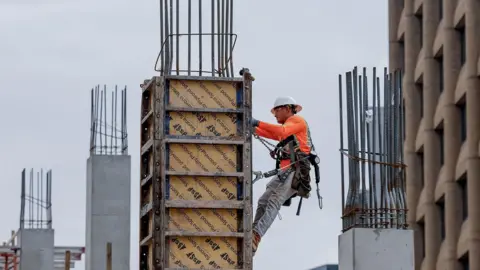The World Bank has recently projected the most sluggish decade for global economic growth since the 1960s, attributing this downturn to the far-reaching effects of tariffs instituted during Donald Trump’s presidency. As countries grapple with changing trade dynamics, the implications of these tariffs have manifested in unfavorable economic predictions for many nations around the world.
In its latest report, the World Bank indicated that nearly two-thirds of countries have experienced a reduction in their growth forecasts compared to previous predictions made just six months ago. Specifically, the bank anticipates a global growth rate of merely 2.3% for the year 2025, which represents a decline of 0.4% from earlier forecasts issued in January. Furthermore, expectations for 2027 have been slightly revised to a projected growth of 2.6%. Notably, major economies including Japan, Europe, and the United States were heavily impacted by these downward revisions, emphasizing the widespread effects of the ongoing economic challenges.
The previous set of forecasts from the World Bank was generated prior to Donald Trump assuming office and implementing a series of trade policies that shifted market sentiments drastically. The introduction of a universal 10% tariff on all imports into the U.S., along with hefty tariffs on steel and aluminum, led to a notable decline in the financial markets in early April of this year. In an interesting turn of events, a trade ruling in May declared the majority of Trump’s global tariffs as illegal, though the administration was able to appeal this decision to maintain them for the time being.
As a result of the escalating trade tensions and their detrimental influence on investor confidence—as well as consumer spending—the World Bank adjusted its growth forecasts for the United States for both the years 2025 and 2026. Conversely, a slight glimmer of economic optimism was found in China, which the World Bank believes possesses adequate financial stability to mitigate the adverse effects stemming from global political uncertainties.
In its assessment, the World Bank signaled that the current global economic landscape has become more complex, warning that the potential for increased trade barriers and uncertain policy shifts may further dampen the economic outlook. They caution that should the U.S. decide to escalate its tariff measures, there could be additional growth reductions along with noticeable inflationary pressures. The report discusses the alarming possibility of global trade becoming stagnant in the latter half of the year, which could, in turn, lead to a dramatic loss of confidence, increased unpredictability, and turmoil in the financial markets. Nevertheless, the World Bank refrained from predicting an outright global recession at this point, suggesting that the likelihood remains below 10%.
The World Bank’s assessments come on the heels of similar evaluations by the Organisation for Economic Co-operation and Development (OECD), which has also downgraded its perspective for the global economy, projecting a slow growth of 2.9%, down from a previous forecast of 3.1%. In light of these developments, a fresh series of trade talks between the U.S. and China took place recently in central London, aimed at alleviating some of the tensions that have persisted throughout these trade disputes.
In summary, the World Bank’s stark predictions outline a challenging economic future shaped significantly by trade policies and geopolitical unrest. As nations continue to navigate these complexities, the broader ramifications of such developments are likely to resonate across the globe, affecting economies large and small.



